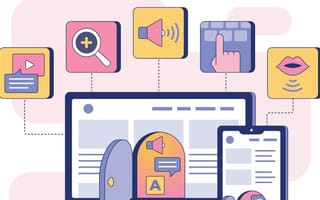Over the course of only a few years, the Chicago Digital Accessibility and Inclusive Design Meetup has hosted dozens of events and grown to nearly 3,000 members comprised of engineers, developers and designers.
The group’s continued growth and presence is emblematic of a simple yet often overlooked truth: in an industry defined by evolving technologies that demands continuous learning, accessibility must not be left on the backburner.
Alissa Bankowski, product design lead at Evive, has over a decade of experience designing for mobile and web applications. Over the years, Bankowski says a big misstep she’s noticed is when designers and developers focus too much on just one aspect of accessibility or another.
“A common misconception about accessibility is that it mainly relates to colors, contrast and fonts. While those are a big piece of the puzzle, there’s so much more that goes into accessibility that isn’t as apparent,” Bankowski explained.
A common misconception about accessibility is that it mainly relates to colors, contrast and fonts. There’s so much more that isn’t as apparent.”
—Alissa Bankowski
Indeed, the inclusive design process often raises more questions than answers, noted Zach Schloss, director of UX at One North Interactive. It’s a challenge he and his team welcome rather than fear. “There’s no magic quick fix to make an experience truly inclusive. Careful planning, user participation and diverse perspectives are all required from the get-go to really make an impact,” said Schloss.
Built In Chicago spoke to Schloss and Bankowski about how their teams approach accessibility and inclusive design, what that looks like in practice and common mistakes to avoid.
One North is a full-service digital agency that works with over 70 brands to guide branding and communication, technology and infrastructure, optimization, digital experiences and more. The TEKsystems company was honored as one of Built In’s Best Places to Work in Chicago in 2022.
What are the key best practices your team has in place when it comes to accessibility?
One North takes great pride in the attention we place on making accessibility and inclusivity a priority. We know that participation is representation. As strategists, designers and technologists, our attention is always on the user. However, we also recognize that any one of us can’t speak for everyone. Maintaining diverse, multidisciplinary and collaborative teams helps us gain perspective. So does involving end users in the design process as much as possible.
On a recent project for a global technology client, we paid close attention to the accessibility of our collaboration and presentations — including meeting transcripts, presentation metadata, verbal descriptions of what we’re sharing on screen and the inclusion of folks who use assistive technologies during our design and testing phases.
User research and testing allow us to gather critical input and the context necessary to shape accessible experiences. Inclusive design, and its process, often surface more questions and challenges than answers — which we welcome, not fear. We know we may not be able to solve every use or edge case, but awareness is the first step to understanding how we can do better next time.
Inclusive design, and its process, often surface more questions and challenges than answers — which we welcome, not fear.”
What does accessible UX/UI design look like in your team’s work?
Context is key. Understanding the user’s abilities, limitations and environment really helps shape how we design an experience that complements their reality. On a recent project for a global airline, we designed interfaces for handheld devices used by ground crew at the airport in all weather conditions, wearing gloves and driving vehicles. We included those folks in our design and testing process to ensure the technology was accessible.
On another recent project for a global technology company, we researched career marketing drivers for diverse roles globally. The diversity of our research panel was very important, we paid close attention to who we talked to and identified who was not in our study. These considerations helped to frame the research insights and design decisions going forward.
We ask things like: Where is the user? What are they doing? What is the lighting like where they are? How acute is their eyesight? Are they in a moving vehicle, which would make it hard to precisely tap a touch screen? Do they have hand tremors? What language do they speak? Are they using a screen reader or other assistive technologies? Can they trust the content they’re reading?
What are some common accessibility related missteps that you often see UX/UI designers make?
At One North, we see three common mistakes. The first is assuming it’s not necessary. Avoiding accessibility doesn’t only make for a bad user experience, it also puts both your brand and your business at risk. Conversely, the results of designing with accessibility and inclusivity in mind do not only benefit those with disabilities or from diverse backgrounds. These design decisions, more often than not, improve the overall experience for all users.
The second common mistake is retrofitting. All too often, accessibility efforts are tacked on at the end of the project. However, there’s no magic quick fix to make an experience truly inclusive. Careful planning, user participation and diverse perspectives are all required from the get-go to really make an impact.
The final mistake is assuming you’re already doing it — or that it’s a one-and-done effort. You can’t design inclusively without doing the work. The fact is, people and technology are always changing. Every time we do research, we learn something new that can be applied to improve the experience.

Healthtech company Evive leverages deep healthcare and HR data to help employees take full advantage of their benefits. Evive’s platform connects employees to all of their benefits in a single location, boosting engagement with resources and programs that target their specific needs and goals.
What are the key best practices your team has in place when it comes to accessibility?
Regarding the accessibility of our products, two of our key areas of focus are structure and adaptability. We start with a solid framework of established design principles and processes: a structure that allows us to better adapt to dynamic elements, such as accessibility standards, design components and so on. In my opinion, accessibility is a lot like software — we’re never truly “done” and our efforts will continuously evolve over time.
Accessibility is a lot like software — we’re never truly ‘done’ and our efforts will continuously evolve over time.”
What does accessible UX/UI design look like in your team’s work?
Consistency and simplicity are key. There are so many factors that go into creating accessible experiences, but ensuring consistency across all aspects of our design and UX is essential. That, combined with building simple, easy-to-use software, gives us the edge we need to provide the ultimate user experience.
Through consistency, our teams of designers and software developers are able to ensure that every aspect of our site is up to standards. From our UI kit to our design approach, to quality-assurance testing and beyond, accessibility is one of our top priorities.
Creating a simple experience is also a key approach for us. It reduces user errors and confusion, provides a clear pathway to various actions they can take, and plays into the overall consistency throughout the entire design and experience.
What are some common accessibility related missteps that you often see UX/UI designers make?
One big misstep I’ve noticed over the years is designers and developers putting too much attention on just one aspect of accessibility. A common misconception about accessibility is that it mainly relates to colors, contrast and fonts. While those are a big piece of the puzzle, there’s so much more that goes into accessibility that isn’t as apparent.
A few examples are things like ALT tags, hover states for interactive elements and keyboard navigation. ALT tags are important because they’re picked up by screen readers, making images accessible to the visually impaired. Hover states and keyboard navigation go hand-in-hand, guiding users through the elements on any given page with clear visual cues.
Something that helps me with accessibility practices when designing is having a set of tools to help test as you go. That way it’s always in the forefront so you can be sure you’re designing for success from the start.
A few of my favorite tools are Coolers’ contrast checker, GitHub accessible matrix and various plugins in Figma, such as Able, Contrast Checker and Color Blind.









